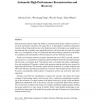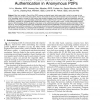955 search results - page 190 / 191 » An Evaluation of Current High-Performance Networks |
CN
2007
13 years 7 months ago
2007
Self-protecting systems require the ability to instantaneously detect malicious activity at run-time and prevent execution. We argue that it is impossible to perfectly self-protec...
TON
2008
13 years 7 months ago
2008
We study the effectiveness of automatic patching and quantify the speed of patch or alert dissemination required for worm containment. We focus on random scanning as this is repres...
TPDS
2008
13 years 7 months ago
2008
Most trust models in Peer-to-Peer (P2P) systems are identity based, which means that in order for one peer to trust another, it needs to know the other peer's identity. Hence,...
ACSAC
2010
IEEE
13 years 5 months ago
2010
IEEE
Instruction-set randomization (ISR) is a technique based on randomizing the "language" understood by a system to protect it from code-injection attacks. Such attacks wer...
ACSAC
2010
IEEE
13 years 5 months ago
2010
IEEE
Conficker [26] is the most recent widespread, well-known worm/bot. According to several reports [16, 28], it has infected about 7 million to 15 million hosts and the victims are s...


